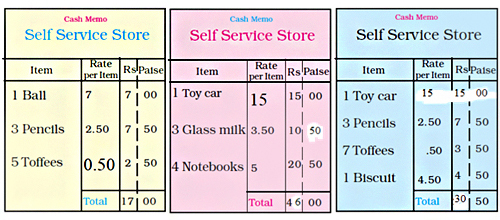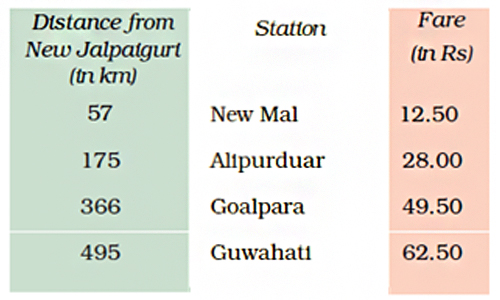a.
| Notes and Coins | Number of Notes and Coins | Amount |
| 50-rupee | 1 | 50-rupee |
| 20-rupee | 1 | 20-rupee |
| 2-rupee | 3 | 3 × 2 = Rs 6 |
| 25-paisa | 3 | 3 × 25 =75 paise |
Hence, the total amount shown is: Rs 50 + Rs 20 + Rs 6 + 75 Paisa = Rs 76 and 75 paise
b. 100 paise = 1 rupee
| Notes and Coins | Number of Notes and Coins | Amount |
| 20-rupee | 1 | Rs 20 |
| 2-rupee | 5 | 2 × 5 = Rs 10 |
| 1-rupee | 1 | 2 × 5 = Rs 10 |
| 50-paisa | 7 | 50 × 7 = 350 = Rs 3 and 50 paise |
| 25-paisa | 5 | 5 × 25 = 125 = Rs 1 and 25 paise |
Hence, the total amount shown is:
Rs 20 + Rs10 + Rs 1 + Rs 3 + Rs 1 + 50 paise + 25 Paise
= Rs 35 and 75 paise
c. 100 paise = 1 rupee
| Notes and Coins | Number of Notes and Coins | Amount |
| Rs 500 | 1 | Rs 500 |
| Rs 100 | 1 | Rs 100 |
| Rs 50 | 1 | Rs 50 |
| Rs 10 | 1 | Rs 10 |
| Rs 5 | 2 | 5 × 2 = Rs 10 |
| Rs 2 | 3 | 2 × 3 = Rs 6 |
| Rs 1 | 2 | 1 × 2 = Rs 2 |
| 50-paisa | 7 | 7 × 50 = 350 = Rs 3 and 50 paise |
| 25- paisa | 11 | 11 × 25 = 275 = Rs 2 and 75 paise |
Hence, the total amount shown is:
Rs 500 + Rs 100 + Rs 50 + Rs 10 + Rs 10 + Rs 6 + Rs 2 + Rs 3 + Rs 2 + 50 paise + 75 paise
= Rs 683 and 125 paise
= Rs 684 and 25 paise
d.
| Notes and Coins | Number of Notes and Coins | Amount |
| Rs 100 | 1 | Rs 100 |
| Rs 50 | 1 | Rs 50 |
| Rs 10 | 1 | Rs 10 |
| Rs 5 | 2 | 2 × 5 = Rs 10 |
| Rs 2 | 2 | 2 × 2 = Rs 4 |
| Rs 1 | 3 | 3 ×1 = Rs 3 |
| 25-Paisa | 1 | 25-Paisa |
Hence, the total amount shown is:
Rs 100 + Rs 50 + Rs 10 + Rs 10 + Rs 4 + Rs 3 + 25 paise
= Rs 177 and 25 paise











_20250425_151704.jpeg)






_20250425_151748.jpeg)













